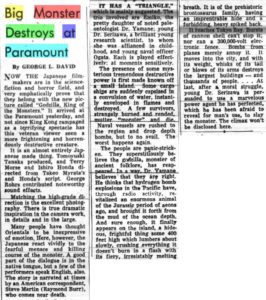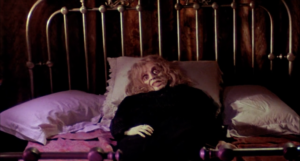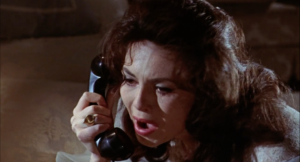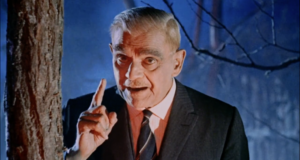Mario Bava’s Black Sabbath (I Tre Volti Della Paura) is a 1963 anthology horror film, featuring three tales of terror. In The Telephone, which is essentially a giallo thriller, a young woman, Rosy (Michelle Mercier), is repeatedly called on the telephone by a man who claims to be watching her. The mysterious caller eventually reveals himself to be her former pimp, Frank, who has escaped from prison. The second story is The Wurdulak, which sees Boris Karloff play a man who returns to his family’s home after allegedly killing the titular creature, an undead ghoul who feeds on the blood of those it loves. A Drop of Water rounds out the anthology, and focuses on a nurse who steals the ring of a dead woman. In true ghost story fashion, she is haunted as punishment.
When I first watched Black Sabbath, I wasn’t all that impressed. I’d enjoyed Bava’s earlier classic, Black Sunday (1960), and though his work on 1959’s Caltiki, the Immortal Monster is disputed, that film is an underrated gem of both ‘50s science-fiction and Italian horror cinema. When it came to Black Sabbath, there was just something that I couldn’t get into.
And yet, I type this having re-watched the film, and having changed my mind. This time, as I sat down to watch it just past midnight, I sank into the irreplaceable timbre of Boris Karloff’s voice, and Mario Bava’s anthology horror finally clicked. But what was different about this viewing? This time, I watched the altered English language dub produced by the masters of exploitation cinema, American International Pictures (AIP) – who also co-financed the production as part of a multi-picture deal with Italian production company Galatea.
As tastes have shifted over the years, something of a hostility towards altered, English language versions of foreign films has developed. It has grown, dare I say, in tandem with a greater accessibility to subtitled versions of older foreign films on home video. The exaltation of “uncut” or “original” versions has stirred an unspoken aversion to the English iterations which first saw these films exported overseas. By all means, having a foreign film’s theatrical release version on home video, complete with subtitles, is a good thing. The DVD (and by extension, blu-ray) era has been a godsend for fans of rare foreign cinema, finally enabling these films to be seen as they were originally presented.
However, this deification of the “original” release versions has led to either outright abandonment of the English language counterparts (ala the Criterion Collection’s recent Godzilla boxset), or a misguided assumption that the original versions are automatically better. Of course, when many English language versions have been altered for their markets, one can assume that – even unintentionally – things will inevitably be lost. But does that mean that these altered versions are always bad?
Ultimately, the version that a person prefers is a matter of personal taste, but with the aforementioned factors, a misunderstanding about the impetus for, the production, and the results of English language versions has developed – one that often assumes malicious intent to harm the message of the original.
It’s important to recognise what such versions have meant in a historical context; one that recognises how the act of changing a film in order for it to be seen overseas was, quite often, an act of faith in the film’s potential; if not an unfortunate but necessary acceptance that there are things that different audiences won’t accept.
As an example, the 1956 iteration of Toho’s Godzilla (1954), titled Godzilla, King of the Monsters!, has taken a great deal of criticism in recent years, and especially since 2004 – the year when the original, Japanese version was finally widely accessible to the public in the West. Godzilla, King of the Monsters! features newly-shot footage of American actor Raymond Burr inserted into the proceedings. Burr’s character, reporter Steve Martin, narrates much of the film, often negating the need for direct dubbing of the Japanese actors through his expository lines. Direct references to the atomic bombings of Hiroshima and Nagasaki were removed (though commentary on atomic weapons firmly remains), and the film itself is restructured so as to be told in flashback.
In his book, Godzilla On My Mind (2004), academic William Tsutsui commented on the changes made to the original film, stating that, “Americanization thus rendered Gojira a standard monster-on-the-loose action film, radiation became a gimmick rather than a moral crisis, and Godzilla was firmly recast in the inoffensive tradition of American atomic-age science fiction cinema.” As recent as 2020, this notion that Godzilla, King of the Monsters! was a deliberately apolitical lobotomisation of the Japanese original has persisted.
This is an interesting take as it ignores the complexities involved in altering a film for a foreign-language market. It also neglects consideration of cultural differences (World War II was just eleven years prior), as well as the inevitable changes that occur when inserting a new actor into a pre-existing narrative. For what it’s worth, while Godzilla, King of the Monsters! does – by virtue of the mode of its creation – lose much of the thematic heft of the original incarnation, to assert that it has been thematically lobotomised ignores the fact that Godzilla is still very openly considered a product of the hydrogen bomb. Moreover, the seriousness with which Raymond Burr approaches the material should be acknowledged. Importantly, even with direct references to Nagasaki removed, the visual onslaught that is Godzilla’s attack on Tokyo and its aftermath are not subtle with what they bring to mind. Tsutsui’s perspective also ignores the fact that several contemporary reviews demonstrate how audiences were still able to pick up on the film’s commentary on nuclear weapons.

Furthermore, while political portions of the 1954 version were removed, this was not done with malicious intent. Producer Richard Kay explained that the political angle did not interest them, and their concern was predominantly in making a marketable film. Yes, this means that King of the Monsters! is no longer overtly political, but this was not the result of deliberate dilution.
This is merely conjecture, but I would hazard a guess and argue that a great deal of the recent derision of Godzilla, King of the Monsters! was drawn from an eager desire to separate it from its ‘pure’ Japanese counterpart. As King of the Monsters! had been the perceived “original” to most people in the Western world for fifty years, and that Godzilla had developed a negative perception of cheapness, the praise that Western critics have lavished on the Japanese version would have been enough for fans to disown the 1956 English iteration. “What? You think Godzilla is bad? No, no, no. You must have only seen the bad English version with Raymond Burr! The Japanese original is much, much better”
This tangentially relates to a broader conversation about the derision of dubbing (a technique that requires skill and craft to be done right), and how a certain snobbery exists about the prestige nature of watching a subtitled film – but that’s another story!
As pointed out by film historian David Kalat, the very act of taking a Japanese product – something which, on its own, had no mass appeal outside of Japan – and exerting the effort to dub it, script and shoot inserts with new actors, and re-edit it (even if some of these efforts seem clumsy in retrospect) shows great faith in the value of the idea. Even the films of the great Akira Kurosawa were not afforded this luxury, often only playing in arthouses or on college campuses. Meanwhile, Godzilla, King of the Monsters! enjoyed a fairly wide release in the English-speaking world – even if some critics weren’t entirely impressed.

All of this is to say that while altered English language versions may not entirely do justice to their original counterparts, their creation often comes as a recognition of the original’s value; that effort should be expended to bring it to a foreign audience. English versions are also vitally important in understanding global release histories of foreign films, examining how different audiences have first perceived them. Godzilla, King of the Monsters! is certainly one of the more distinct examples of English language alteration, but it is also a good example of how such changes can happen and still be creatively legitimate.
This wild detour finally brings me back to Black Sabbath. Upon my recent re-watch, I found myself engaging with and enjoying the English version much, much more than the Italian original. In order to try and explain what made the film more appealing this time around, it’s important to explore the changes made to the English version and their impact upon the film as a whole.
Most significant is the reordering of the stories. In the Italian original, The Telephone is the first story. In the AIP version, A Drop of Water is moved to become the inaugural tale. In this critic’s humble opinion, this makes for a much stronger opening. Indeed, A Drop of Water is nothing short of terrifying. I defy you to forget the grotesque visage of the dead woman to whom the nurse attends. Also in this critic’s opinion is the belief that A Drop of Water is Black Sabbath’s best tale. It may seem counterintuitive to place your strongest work at the beginning if the remaining two stories don’t match it, but the significance of this choice is clear when one considers how interminably dull The Telephone is – let alone as the picture’s first story.

If Bava’s work shows anything, it is his design and lighting prowess. From the high contrast black and white photography of Black Sunday to the deliciously haunting use of deep reds in his later works like Planet of the Vampires (1965), Bava’s knack for creating hyper realities of vivid imagery lends itself well to Black Sabbath’s inherent melodrama – especially in the AIP version. It is a shame then that The Telephone features over-lit sets that deny any chance of the brilliant use of shadows that Bava flaunts in his other work.
Furthermore, the story is painfully slow. As the opening tale, its lack of pace immediately sullies the momentum stirred by the film’s prologue (a masterful delivery by Boris Karloff). Moreover, in the Italian original, there is nothing supernatural at play. While in concept it is still a scary idea, the visual presentation, pacing, and music aren’t really cohesive, and so the tale becomes a chore to sit through. In the AIP version, Frank is not Rosy’s pimp, but simply a madman whose connection to her is undisclosed. Importantly, it is said that Frank has been dead for some time, lending an air of the supernatural to a story that previously had none; though, it must be said, this cannot truly salvage The Telephone.
In placing A Drop of Water first, we are catapulted to immediate horror greatness as the panicked and nightmarish world of a haunted woman closes in around us. Unlike in The Telephone, Bava is in his element here and the sets are bathed in shadows with occasional splashes of striking colour. The set and colour design become part and parcel of the nurse’s panic. As mentioned, the stare of the dead woman’s corpse will pierce your soul and linger uncomfortably.
The first scene of a film must grab you. On my first watch of Black Sabbath, having been tempted by sleep during The Telephone, my subdued enjoyment hurt my engagement for The Wurdulak, and I was only truly held during A Drop of Water – by which time I had already felt moderately disappointed in the film as a whole.
However, after the thrills that A Drop of Water offered, I was much more receptive to The Telephone (now the second story in the AIP version). The Telephone still remains the weakest of the three in my estimation, though I found myself more appreciative of its merits; there are individual moments of terrific performance that sell the terror of the situation, such as when a single tear rolls down Rosy’s cheek as she listens to Frank’s latest maniacal monologue.

Regarding The Wurdulak, hearing Boris Karloff’s original vocal delivery (dubbed in the Italian version) was magnificent. Karloff turns in a remarkably frightening performance as the titular monstrosity, and scenes in which he turns his attention to his daughter’s infant son are palpably unsettling. It must also be said that Karloff’s voice, by virtue of it being his (coming with all of the connotations that his name and iconography bring), automatically lends the tale a suitably spooky atmosphere in a way that the original version can’t.
Speaking of Karloff, the AIP iteration features interludes with him between each story wherein he speaks directly to the audience; the original version only features Karloff at the film’s beginning and end. To a modern eye, such moments may seem antiquated, but if you’re a fan of William Castle, or indeed Rod Serling’s introductions to each Twlight Zone episode, then Karloff’s interludes draw you into the fun of the horror.
This brings me to what I wish had been kept from the Italian original. At the end of Bava’s version, Karloff appears in his Wurdulak garb atop a horse. As a he speaks to the audience, the camera eventually pulls back. It’s revealed that Karloff is sat atop an artificial horse, prop-men are rushing around him with fake branches to simulate movement, and all of this is happening on a sound stage.
As film historian Roberto Curti explains, “at this point a final sermon would be expected, drawing a moral conclusion to the stories and closing the circle, which indeed happens. Yet, by revealing the illusion of the set and demystifying Karloff’s role – an idea which the director improvised on set on the last day of shooting, after receiving a telegram from AIP which asked him to lighten the episode’s scary finale – Bava strips the elderly horror icon of that authority which the audience ascribed him, and which he himself invested Karloff with in the prologue”

What’s interesting is that, despite their insistence on this ending’s creation, AIP did not include it in their version. Arguably, this ending would have complemented Karloff’s prior interludes. Those sequences, in their disregard for the fourth wall, draw you to a place behind the camera and behind the stories. Karloff’s direct conversation makes you a more active participant in the proceedings, and indeed the Italian version’s ending would have seen that idea come full circle had it been included in AIP’s version. Just as Karloff is clearly in on the horror as he introduces the stories, the Italian ending clues us in as well; we are not merely viewers anymore but, in seeing how it’s done, we are producers as well. In essence, we create our own horror.
That may be what I took away most from this viewing. I watched Black Sabbath as an audience member, but also as someone aware of the mechanics of its construction. As I clung to the edge of my seat during A Drop of Water, I was also fascinated by the film’s beautiful theatricality. As anthology horror films often recall the fun of telling ghost stories late at night, the act of telling the story is just as integral as the act of listening. In Karloff’s interludes, the AIP version of Black Sabbath fulfilled that tradition for me.
This feeling is galvanised when I look at the press material that AIP assembled for the picture’s release. AIP’s “SEAT SELLING SLANTS” included selling “Wurdulak kits” to local TV and radio commentators, and challenging volunteers to sit through a screening alone. Such gimmicks make one aware of just how rich an experience it must have been to have seen this in a theatre in 1963. Whether or not every theatre indulged in AIP’s suggestions is unknown, but that they were suggested at all only adds to the delight.

Of course, I still appreciate the Italian original, and home video distributors like Arrow Video (whose release of the film I watched), who include both the original and English versions of their releases, must be commended for fostering that appreciation. Not every English language version will remain totally faithful to the original, but many produce remarkable, alternative ways for a story to be experienced. Indeed, it’s also important to remember that with AIP co-financing Black Sabbath, any changes they made have at least a hint of authorial ownership – even if sometimes made without explicitly artistic intent.
With this article’s wild detour into Godzilla’s territory, I am hopeful that a renewed appreciation for English language versions of foreign films can be had. This is not to say that these versions are better or more important than their original counterparts, but rather that they are an integral part of how these films have been experienced globally. For better or worse, these versions demand preservation for their historical significance, and their complex production stories often muddy the water in what has previously been a black and white conversation of their quality.
Following this particular experience, perhaps it’s time that I revisited the English-dubbed version of Godzilla Raids Again (1955), the sensationally titled Gigantis the Fire Monster…wish me luck.
